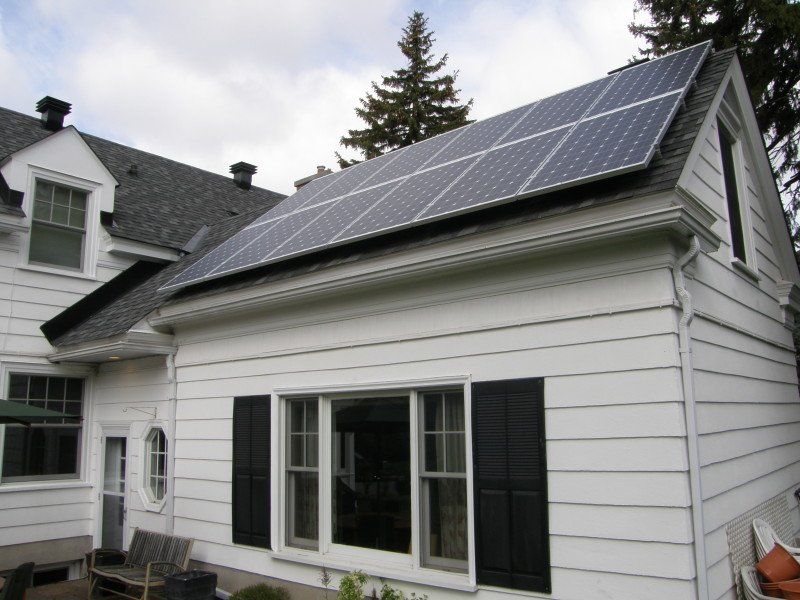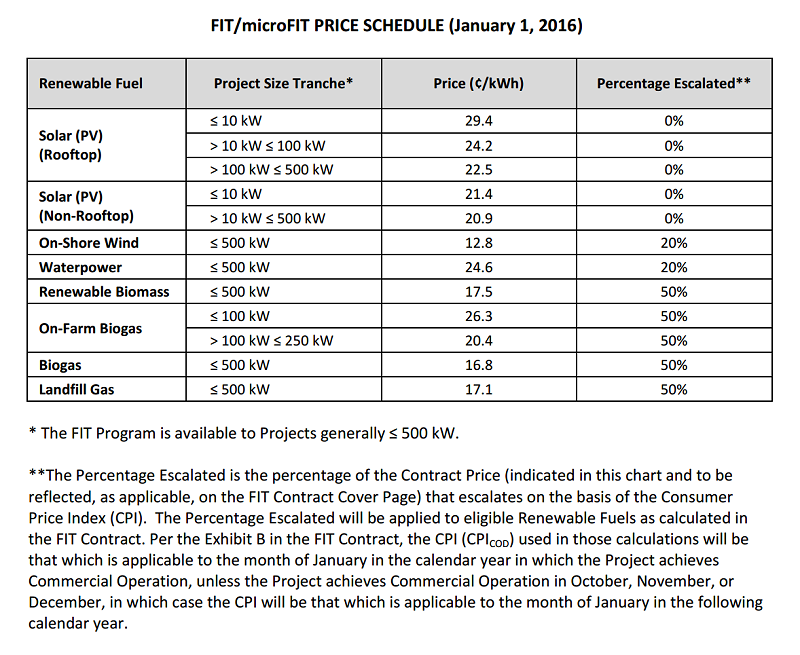The Ontario MicroFIT Program
Ontario’s MicroFIT program is closed for new applications, since December 2017. Those with an existing contract will of course continue to receive revenue for the 20 years of their contract. For those looking to include solar panels to their house there is Net-Metering. This exists not only in Ontario, but in all of Canada’s provinces. The information below is dated, we’re just keeping it around for historical reasons (and it may still be of interest to some).
When it is sunny, your rooftop can be making money!
You can get a much better rate-of-return than the bank by taking advantage of Ontario’s MicroFIT program, administered by the IESO. This program currently pays 29.4 cents per kWh of rooftop PV energy. For a good south-facing roof that results in an annual rate-of-return that could be as much as 11.1%, year after year, for the contract term of 20 years! We can help you with the DIY supplies, design services, and advice to make a code-compliant MicroFIT installation.
The MicroFIT program is for solar systems of up to 10kW, and in most places the panels have to be mounted on the roof, in some instances ground mounting is possible. This program is of interest to homeowners, farmers, churches, municipalities, universities, schools, co-ops, hospitals, and aboriginal communities. Let us help you earn a steady return from MicroFIT.
Why Solar Power?
There are lots of reasons to install solar panels on your roof: Some people want to be a little more green in their lives, some want to help our planet by producing green electricity, others are more interested in earning revenue from solar power, as an investment. For most it is a combination of many factors. Now that the Independent Electricity System Operator (IESO) offers 29.4 cents for every kilo-Watt-hour (kWh) of rooftop solar electricity sold to the Ontario grid, with a fixed-price guaranteed 20-year contract, there is a reason for everyone to put a solar PV array onto their roof!
When installed properly a solar array will last much longer than the 20-year contract term. Solar modules come with a 25-year warranty. In fact, they should be producing electricity for 30 or 35 years. That means you will have a fully-paid-for PV array sitting on your roof at the end of the IESO contract that can then be used to offset your own electricity use through net-metering. Yet another reason to install solar.
In case net-metering becomes more profitable than MicroFIT before the 20-year contract term is up, you can cancel the MicroFIT contract and switch over to net-metering.
Your Rooftop Can Make You Money!
The IESO pays you for energy made from sunshine that you feed into the Ontario grid, through their Feed-In-Tariff (FIT) program. Systems up to 10 kW fall under the Ontario MicroFIT rules, while larger systems use the more complicated FIT program rules. The contracts with the IESO are for a 20-year time period, and they pay a guaranteed fixed rate for each kWh you sell to the grid. The solar power rates are listed on table to the right (click it to see a larger version).
For most home owners the 10kW-and-under category is the most interesting one. The IESO currently pays 29.4 cents per kWh sold to the grid. If you have a roof that faces between east and west, with limited shading between 9am and 3pm in summer, you can make money! Each kilo-Watt of solar PV requires around 85 square feet of roof space. In case you are not sure if your roof will work for solar energy, just give us a call and we will be happy to schedule a site survey.
So, How Much Money Can My Rooftop Make For Me?
In the Ottawa area, for solar modules facing south at the proper angle, every 1 kW of PV will produce around 1175 kWh per year. This is a somewhat conservative estimate, taking real-world efficiencies into account. When the panels are brand new production will likely be a little higher, but at the end of the 20-year contract period it will likely be a little lower. In short, 1175 kWh per year is a good estimate to work from.
Using 1175 kWh per year and 29.4 ct/kWh, each 1 kW of PV modules will generate $345 of income per year for rooftop mounted solar PV. This is for systems of 10 kW in size and under.
Now that we have the annual number, we can calculate income over the entire contract period. Every 1 kW of PV can be expected to generate $6,909 of total income over the 20-year Ontario MicroFIT contract period. For a 10 kW MicroFIT system this works out to$69,090 in income. This scales with size of course; a 5 kW array can be expected to generate 5 x 6,909 = $34,545 in income, and so on. These are real-world numbers, without exaggerating production as many PV installers seem to be doing these days!
Ontario MicroFIT Installation Cost
There are many full-service solar installations companies, and if you want the job done for you that is the route you should take. However, if you posses good DIY skills and are not afraid of working on a roof then a Do-It-Yourself MicroFIT installation could be in the cards for you: This can save quite a bit of money and make payback and Return-On-Investment significantly better!
We can help you with a DIY installation; we have a decade of hands-on experience installing solar, and can point out the does and don’t s. We can also help you with electrical code questions, and the administrative process around MicroFIT.
You should be honest with yourself about your skills and abilities. Installing solar PV is not rocket science, though it is not a beginner’s project either. It is legally allowed to do your own electrical work (with a permit), however, we would strongly suggest teaming up with an electrician. Not just for the invaluable advice they can give you, but also to have an electrician do the AC wiring such as replacing the meterbase with a dual-meter version, and to deal with the ESA and your LDC.
The costs of materials for a 10kW grid-tie solar PV system, including sloped-roof racking and shipping, are around $16,500 at the time this was written (April 2016). On top of that come the LDC fees ($1,500), roof engineering analysis ($700), electrician fees plus materials ($2,000), and permits ($500 – $750). That brings the fixed costs, which you will have regardless of system size, to around $5,000, and overall cost for a 10kW MicroFIT to $21,500 plus your time (you can get all the HST back, so that part is not a cost).
With those numbers, an estimate of the financials for a MicroFIT system looks as follows:
| Array Size (kW) | Price Per Watt (CAD) | Total Price (CAD) | Payback (years) | Annual ROI (%) | 20 Year Revenue (approx.) | 20 Year Profit (approx.) |
|---|---|---|---|---|---|---|
| 3 | $3.33 | $10,000 | 9.6 | 5.4% | $20,730 | $10,730 |
| 4 | $2.90 | $11,600 | 8.4 | 6.9% | $27,640 | $16,040 |
| 5 | $2.66 | $13,300 | 7.7 | 8.0% | $34,550 | $21,250 |
| 6 | $2.48 | $14,900 | 7.2 | 8.9% | $41,450 | $26,550 |
| 7 | $2.37 | $16,600 | 6.9 | 9.6% | $48,360 | $31,760 |
| 8 | $2.28 | $18,200 | 6.6 | 10.2% | $55,270 | $37,070 |
| 9 | $2.21 | $19,900 | 6.4 | 10.6% | $62,180 | $42,280 |
| 10 | $2.15 | $21,500 | 6.2 | 11.1% | $69,090 | $47,590 |
Note: The payback, ROI numbers and approximate 20 year revenue assume the PV array is south facing at a 35 – 45 degree pitch. Any deviation from this, or shading, will diminish the payback and return numbers.
What About Payback, and Return-On-Investment?
You are asking the right questions!
Payback, sometimes referred to as “simple payback”, is the time in years that it takes to earn back the money you invested into your solar array. Being green is one thing (and a good thing!), but you would still like to earn back your investment before the contract runs out, thank you very much! The return-on-investment (ROI) puts a number on your profit, as an annual percentage. The ROI is very much like the APY number banks use to tell you what return to expect on your money. Both are good measures, if used properly, and both depend on how much you pay for the array.
Let us use a real-world example; a 10 kW roof-mounted PV array that you install yourself (with some help from an electrician) will set you back $21,500.
From the above numbers, you can expect this PV array to generate $3,455 per year in income, and $69,090 over its 20-year contract time.
The simple payback time for this array is therefore 21,500 / 3,455 = 6.2 years.
After this time your solar array is fully paid back by the income from your MicroFIT contract. For the remainder of the 20-year contract period you are making a profit!
For the ROI you need to know how much you will have left over after the 20-year contract period has ended, and this is your income minus the cost, or 69,090 – 21,500 = $47,590 in profit over 20 years.
Now that we know profit, it is easy to calculate the ROI as the percentage of profit in comparison to your investment (the cost) per year. The ROI is (47,590 / 20) / 21,500 = 11.1% annually. That is a much better than what the bank will pay you for your money at the time this was written (with interest rates on savings accounts at around 0.5%)!
Be aware that many PV installers conveniently ‘forget’ about the money you invested and only look at the income to calculate payback time and profit. This is wrong, misleading, and results in ROI numbers that are not realistic. Do not fall for that trick!
Another popular scam that is heavily promoted by PV installers is to calculate ROI numbers when financing of the solar array is involved. Unfortunately the whole return-on-investment concept does not work so well for financed projects, as it is easy to get double digit, triple digit, or even infinite ROI numbers that way. Imagine putting in 1 cent of your own money and financing the other $31,994.99 of the solar array. Most of the revenue will go to the bank, but at the end of the 20-year contract you may still walk away with, say, $1,000 in profit. That would make for a whopping ROI of (1,000 / 20) / 0.01 = 500,000% annually (“Yeah Baby”, as Austin Powers would say!!). Clearly the ROI concept is falling apart here, and is better to look at actual profit. Do not let ROI numbers mislead you!
Financing can still be a good thing, and many MicroFIT owners managed to roll the cost of installation into their mortgage, or get a home-improvement loan to finance the system. As long as you realize that some of the solar energy profit will go towards paying the bank instead of lining your pocket. You do end up with a fully paid for (and in a real sense ‘free’) solar array at the end of the ride, that may be put to productive use to lower your hydro bill after the 20-year contract time is up. You also contribute by producing green energy. Nothing wrong with that!
Can I Mount Solar Panels on the Ground?
Under the current Ontario MicroFIT rules it has become very difficult to install ground-mounted solar PV. Your property needs to be zoned such that it is not meant for residential use (agricultural zoning, with residential use ancillary is allowed). For commercial or industrially zoned land the addition of solar PV has to be of secondary use, it can not be primarily used for solar PV. The property that is to be used for ground mounted solar PV cannot abut a residential zoned property either (and the IESO takes ‘abut’ to have a very wide meaning; even if there is a 45-foot wide road between your property and the residential zoned neighbors it is still not allowed, unless that road is a ‘highway’ or a railway).
If you believe your property qualifies for ground mounted solar we can help you with ground-mounted racking. Cost will be slightly higher than roof mounted.
The Canada Revenue Agency and Your MicroFIT
As far as the CRA is concerned you have just become a small business when you sign a MicroFIT contract. You are manufacturing and selling electrical energy! The bad part is that MicroFIT or FIT income is taxable. The good part is that you can deduct all legitimate business expenses, to offset that income. The entire solar array installation is deductible under the Capital Cost Allowance (CCA) rules. The same goes for insurance expenses, hydro fees, maintenance cost, and even a reasonable amount that you put aside for future use to replace parts (for example, you can put away money to replace the inverters after 10 years, even if they will not need to be replaced). You can even get the HST that you paid for the installation refunded, by applying for a (free) HST number.
Of course, we are no accountants and you should talk to one to make sure. However, with some creative, and perfectly legal bookkeeping, you should be able to offset all income for the first 10 years of the contract, and avoid paying tax on it.
What Effect Does MicroFIT Have on Your Real Estate Tax and MPAC?
At this time MPAC does not have a mechanism to assign value to a solar photovoltaic installation, and it should not affect your property tax. It may creep indirectly into the tax you pay in case you purchase a property that already has solar installed on it. This is because you will likely pay a premium for a property with a PV array, and the MPAC assessment is based in part on the property’s last sale price.





